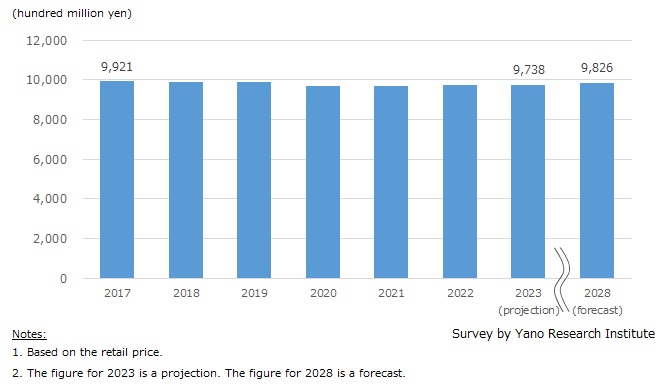No.3440
Flower & Ornamental Plants Market in Japan: Key Research Findings 2023
Size of Flower & Ornamental Plants Retailing Market in 2023 Projected to Attain 973.8 Billion Yen, 100.1% of Preceding Year
Yano Research Institute (the President, Takashi Mizukoshi) has carried out the survey on the flower and ornamental plants market in Japan, and found out the market size, the market player trends, and future perspective. This press release denotes the transition and forecast of the retailing market size of flower and ornamental plants.

Market Overview
The flower and ornamental plants retailing market is expected to attain 973.8 billion yen in 2023 (100.1% of the preceding year). Although people’s flow is recovering in line with the reclassification of COVID-19 to Class-5 infection disease and the demand is recovering for flowers and ornamental plants used at events and commercial facilities, the market as a whole is yet to return to the pre-pandemic level.
Because of the uncertainty of the global situation, as well as the depreciation of the yen and soaring costs in production and distribution, the price of flowers is skyrocketing, and supply conditions are deteriorating. For these reasons, flower retailers have decided to revise their retail prices.
Despite the efforts by flower shops to differentiate themselves from supermarkets, home centers, and other mass merchandisers by quality and design of plant arrangements, consumers are increasingly shifting to supermarkets and home centers, where they can purchase fresh products at cheaper price.
Noteworthy Topics
2024 Problem in Logistics
Logistics is a critical social infrastructure that enables people's daily lives and commercial activity. However, the lack of truck drivers in Japan is worsening. Lifestyle changes brought on by the COVID-19 crisis, as well as an increase in redelivery rates for residential deliveries due to the rapid spread of internet shopping, have exacerbated the situation.
Furthermore, 'attentive' services that cater to shippers' needs result in increased small-lot frequency, inefficient loading, and longer freight wait times. As these conditions grew engrained in the industry, excessive driving hours became an industrywide problem.
While initiatives have been taken by logistics companies to improve productivity and ensure sustainability, the "Act on the Establishment of Relevant Laws to Promote Workplace Reform (Workplace Reform Related Law)" was enacted in 2018, capping truck drivers’ annual overtime to 960 hours per from April 1, 2024.
As the act limits work hours of truck drivers, it may lead to a significant weakening of the domestic road transportation, stagnating distribution. This is called the "2024 problem of logistics” and a concern is growing.
Meanwhile, the flower and ornamental plants industry is working to improve loading efficiency by standardizing transportation packaging, such as the size of distribution containers, and developing distribution centers equipped with refrigeration facilities. In addition, the industry is considering combining of transportation means such as ferries and trucks.
Future Outlook
One of the most significant difficulties flower and ornamental plant businesses are facing is the creation of demand for cut flowers. Considering that the demand tends to be higher for products with distinctive features, seed and seedling manufacturers are focused on the research and development of products such as “flowers that come in special colors and/or shapes”, “flowers that are pollen-free”, “flowers that normally bloom in other season”, “flowers that are disease resistant," and "mass-yielding flowers".
A new demand observed, especially among younger consumers, is the demand for fresh flowers that are artificially dyed in colors different from their original color. While dying of plants was not taken favorably in the past, improvements in dyeing technology that allow colors to look natural, which harmonizes with the look of natural fresh flowers, seems to have propelled the demand. The demand is also growing in the last couple of years for flowers for “oshikatsu”*, where consumers choose flowers in colors that match with their favorite characters.
To generate demand for flowers, cross-industry measures are important, including development of products that translates consumer needs, cooperation of producers, fostering of production bearers, and co-branding with distributors and retailers. In terms of sales channel, new services that enable consumers to purchase flowers on a day-to-day basis handily are increasing presence in addition to the conventional flower shops and supermarkets, such as flower subscription service that home deliver flowers to consumers weekly or biweekly, and online shops.
(*Translator’s note: “Oshikatsu” is the act of enthusiastic supporting of someone, such as a popular idol and an anime character, that one feels particular devotion to.)
Research Outline
2.Research Object: Seed and seedling makers, wholesalers & retailers of flowers and ornamental plants, importers of cut flowers, online businesses, etc.
3.Research Methogology: Face-to-face interviews by our expert researchers (including online interviews), survey via telephone and email, and literature research
What is the Flower & Ornamental Plants Market?
In this research, the flower and ornamental plants market includes plants used to decorate homes, offices, and commercial facilities, as well as plants utilized on social media, plant/flower subscription services, gift plants, and related products.
<Products and Services in the Market>
Cut flowers, seedlings for flower beds, flowering trees, bulbs, pot flowers, turf and other ground covering greens, preserved flowers, funeral flowers, etc.
Published Report
Contact Us
The copyright and all other rights pertaining to this report belong to Yano Research Institute.
Please contact our PR team when quoting the report contents for the purpose other than media coverage.
Depending on the purpose of using our report, we may ask you to present your sentences for confirmation beforehand.